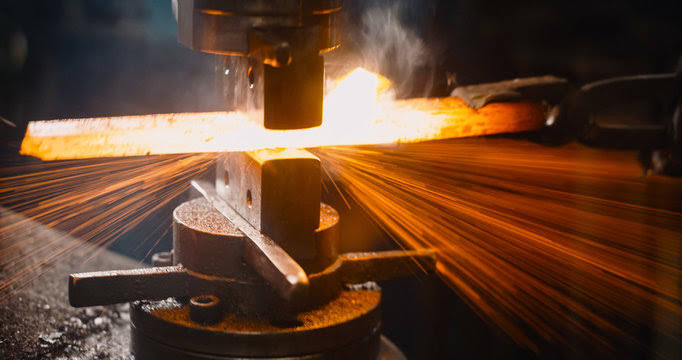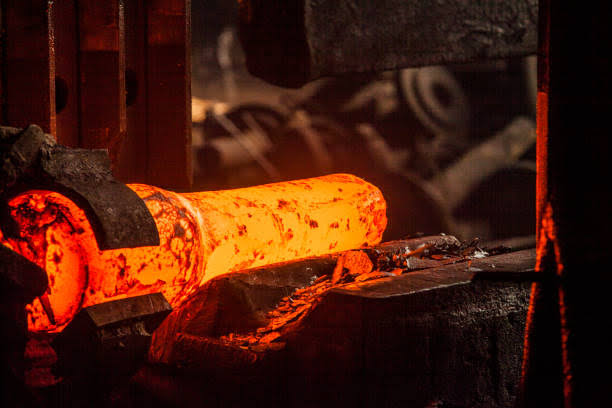


At Hindustan Foundries, forging is more than just shaping metal — it’s a precision-controlled process that enhances strength, toughness, and durability for critical industrial applications. We forge carbon steel, alloy steel, stainless steel, and non-ferrous metals such as aluminium, brass, and copper, serving sectors like automotive, oil & gas, defence, construction, and heavy machinery.
Forging is a manufacturing method where compressive forces are applied to shape metal. It is typically done by hammering, pressing, or rolling the heated metal. This process alters the internal grain structure, improving the mechanical properties, including tensile strength, impact resistance, and fatigue life.
Forging has evolved from ancient hammering techniques into an advanced, high-precision industry. Today, at Hindustan Foundries, we combine modern presses, dies, and thermal control systems to produce high-performance parts efficiently and reliably.

1. Heating
• Raw material (ingots or billets) are heated close to their recrystallization temperature to make the metal malleable.
• Precision-controlled furnaces are used to ensure uniform heating and avoid thermal stresses.
• Heating allows us to reshape the metal with minimal resistance, preserving grain integrity.
2. Preforming
• The heated metal is pre-formed using hammers or presses to match the approximate shape.
• Edging and blocking operations are performed to prepare the metal for final die forging.
3. Finish Forging
• The preformed metal is pressed into closed dies with precise cavities.
• Simple parts may require one press; complex components may need multiple die stages.
• This is where the metal begins to resemble the final component design.
4. Cooling
• Controlled cooling is critical to set the desired grain flow and prevent cracking.
• Excess material, called flash, flows out and is later trimmed.
5. Finishing
• Flash is removed, and the forged part undergoes trimming, machining, grinding, or surface treatment to meet dimensional and functional requirements.
• Surface treatments enhance corrosion resistance and visual appeal.
The following operations are performed during finish forging to achieve exact shapes and properties:
• Cutting – Reducing metal size using chisels or mechanical cutters.
• Upsetting – Increasing cross-section by compressing length.
• Drawing Out – Reducing cross-section while increasing length.
• Jumping – Shortening and thickening the metal.
• Bending – Forming rods or plates into curves or angles.
• Fullering – Spreading metal using upper and lower fullers.
• Edging – Confining metal between die edges.
• Punching/Drifting – Creating holes in hot metal.
• Setting Down – Smoothing seams and edges.
• Forge Welding – Joining heated metal pieces under pressure.
• Swaging – Forming precise circular or hexagonal profiles.
1. Hot Forging
• Performed above recrystallization temperature.
• Prevents work hardening, ideal for large and strong parts.
Advantages:
• Less force required.
• Higher ductility and refined grain structure.
Applications:
• Crankshafts, gears, connecting rods, aerospace and defence parts.
2. Cold Forging
• Performed at room temperature using high pressure.
Advantages:
• High production rate.
• Excellent surface finish and dimensional precision.
Applications:
• Automotive parts, shafts, fasteners, brake systems.
3. Drop Forging
• Involves dropping a hammer on a workpiece in impression dies.
Types:
• Open-die for simple shapes.
• Closed-die for complex precision parts.
Applications:
• Bucket teeth, flail hammers, auger bits, crankshafts.
4. Press Forging
• Metal is shaped using gradual, continuous pressure in a die.
Advantages:
• Complete deformation of material.
• High dimensional accuracy.
Applications:
• Nuts, bolts, valves, levers, aerospace hardware.
5. Upset Forging
• Increases diameter by compressing the length of a bar.
Applications:
• Screws, nuts, bolts, valve components.
6. Roll Forging
• Deforms a round or flat bar between two rotating rolls.
Applications:
• Gears, axles, and symmetrical parts with elongated shapes.
Advantages of Forging (Overall)
• Stronger than cast or machined parts
• Exceptional fatigue and impact resistance
• Efficient material usage and low waste
• Enhanced grain flow and directional strength
• Suitable for high-load, high-wear applications

Limitations of Forging
• Not ideal for highly intricate shapes
• Time-consuming for very large parts
• Limited to ductile metals like steel, aluminum, titanium
• Initial tooling and die cost can be high
Applications of Forging
• Automotive: Axles, gears, crankshafts
• Oil & Gas: Flanges, SS fittings, rig hardware
• Defence: Gun barrels, missile components
• Power & Energy: Turbine shafts, generator parts
• Tools: Wrenches, hammers, drill bits
• Industrial Machinery: Bearings, couplings, shafts
Hindustan Foundries Private Ltd
X111 /232,233 Vellani P.O
Thrissur District,
Thrissur-680701, Kerala, India